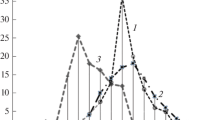Abstract
Plants grown in large numbers for commercial purposes are usually set out on a regular grid, triangular, square or hexagonal, or possibly a rectangular grid. We need to understand their behaviour when they compete with each other for light, water and nutrients. In a greenhouse, there may be a lamp over each plant, half the plants having their lamps on and half off. The intensity of light falling on any particular plant is determined mainly by whether its own lamp is on, next by the number of its nearest neighbours whose lamps are on, and perhaps also by the number of its second-nearest neighbours whose lamps are on.
Such arrays are also used to study competition among different types of plants and, with some extra restrictions, to design field layouts as well. The problem of constructing suitable arrays was introduced in [CORMACK, R. M.: Spatial aspects of competition beween individuals. In: Spatial and Temporal Analysis in Ecology (R. M. Cormack and J. K. Ord, eds.), International Co-operative Publishing House, Fairland, Maryland, USA, 1979] and discussed in [GATES, D. J.: Competition between two types of plants with specified neighbour configurations, Math. Biosci. 48 (1980), 195–209]. Here we consider only the square grid.
Similar content being viewed by others
References
BAUMERT, L. D.: Cyclic Difference Sets. Lecture Notes in Math. 182, Springer-Verlag, New York, 1971.
CLAPHAM, C. R. J.: When a fabric hangs together, Bull. London Math. Soc. 12 (1980), 161–164.
CORMACK, R. M.: Spatial aspects of competition beween individuals. In: Spatial and Temporal Analysis in Ecology (R. M. Cormack, J. K. Ord, eds.), International Cooperative Publishing House, Fairland, Maryland, USA, 1979.
DAVIS, P. J.: Circulant Matrices, John Wiley and Sons Inc., New York, 1979.
DAY, R.— STREET, A. P.: Sequential binary arrays I: The square grid, J. Combin. Theory Ser. A 32 (1982), 35–52.
DELANEY, C.: When a fabric hangs together, Ars Combin. 21–A (1986), 71–79.
FINE, N.: Classes of periodic sequences, Illinois J. Math. 2 (1958), 285–302.
FREEMAN, G. H.: Nearest neighbour designs for three or four treatments in rows and columns, Util. Math. 34 (1988), 117–130.
GATES, D. J.: Competition between two types of plants with specified neighbour configurations, Math. Biosci. 48 (1980), 195–209.
GILBERT, E. N.— RIORDAN, J.: Symmetry types of periodic sequences, Illinois J. Math. 5 (1961), 657–665.
GRUNBAUM, B.— SHEPHARD, G. C.: Tilings by regular polygons, Math. Mag. 50; 51 (1977; 1978), 227–247; 205–206.
Encyclopaedia of Mathematics (M. Hazewinkel, ed.), Springer Online Reference Works, http://eom.springer.de/S/s090150.htm.
HONSBERGER, R.: Mathematical Gems II, Chapter 8. Dolciani Math. Exp. 2, Mathematical Association of America, Washington, DC, 1976.
HOSKINS, J. A.: Factoring binary matrices: A weaver’s approach. In: Combinatorial Mathematics IX (Brisbane, 1981). Lecture Notes in Math. 952, Springer-Verlag, Berlin-New York, 1982, pp. 300–326.
HOSKINS, J. A.— HOSKINS, W. D.: A faster algorithm for factoring binary matrices, Ars Combin. 16–B (1983), 341–350.
HUTCHINSON, J. P.: On words with prescribed overlapping subsequences, Util. Math. 7 (1975), 241–250.
NESTER, M. R.: Sequential arrays, Util. Math. 51 (1997), 97–117.
NESTER, M. R.: Mathematical investigations of some plant interaction designs. PhD Thesis, The University of Queensland, Brisbane, Australia, 1999.
PRAEGER, C. E.— NILRAT, C. K.: Sequential binary arrays and circulant matrices, J. Aust. Math. Soc. (A) 42 (1987), 330–348.
PRAEGER, C. E.— STREET, A. P.: Characterisation of some sparse binary sequential arrays, Aequationes Math. 26 (1983), 54–58.
ROBINSON, P. J.: Balanced cyclic binary arrays, Ars Combin. 21 (1986), 189–199.
RYAN, P.: Private communication.
STREET, A. P.— DAY, R.: Sequential binary arrays II: Further results on the square grid. In: Combinatorial Mathematics IX. Lecture Notes in Math. 952, Springer-Verlag, New York, 1982, pp. 392–418.
STREET, A. P.— MACDONALD, S. O.: Balanced binary arrays I: The square grid. In: Combinatorial Mathematics VI, Lecture Notes in Math. 748, Springer-Verlag, New York, 1979, pp. 165–198.
WILKINSON, G. N.— ECKERT, S. R.— HANCOCK, T. W.— MAYO, O.: Nearest neighbour (NN) analysis of field experiments, J. R. Stat. Soc. Ser. B Stat. Methodol. 45 (1983), 151–211.
Author information
Authors and Affiliations
Corresponding author
Additional information
(Communicated by Peter Horák)
This work was partly supported by an Australian Research Council Discovery Grant.
To Alex Rosa, on the occasion of his seventieth birthday
About this article
Cite this article
Street, A.P., Nester, M.R. An introduction to balanced sequential arrays on the square grid. Math. Slovaca 59, 177–192 (2009). https://doi.org/10.2478/s12175-009-0116-5
Received:
Published:
Issue Date:
DOI: https://doi.org/10.2478/s12175-009-0116-5




